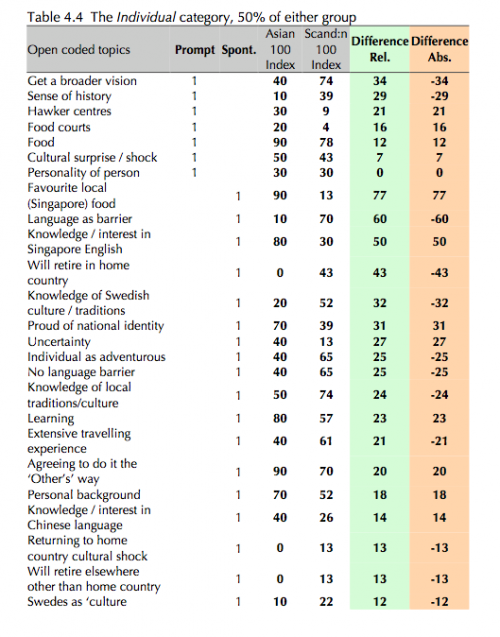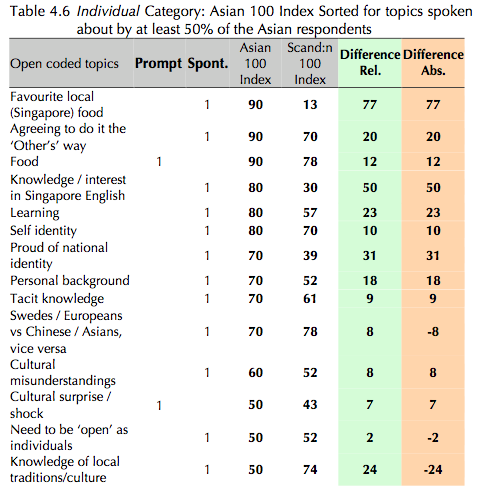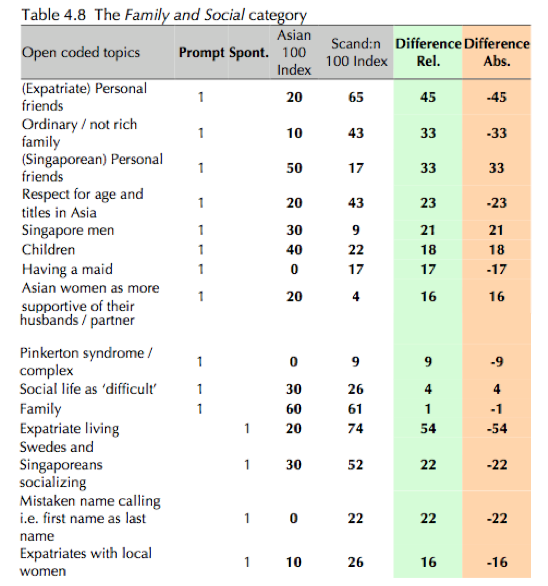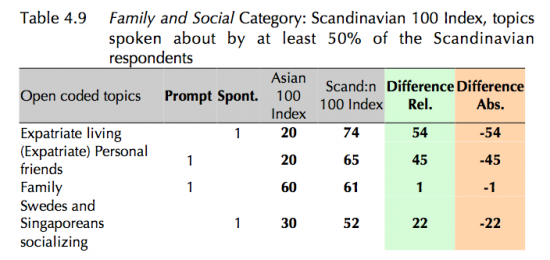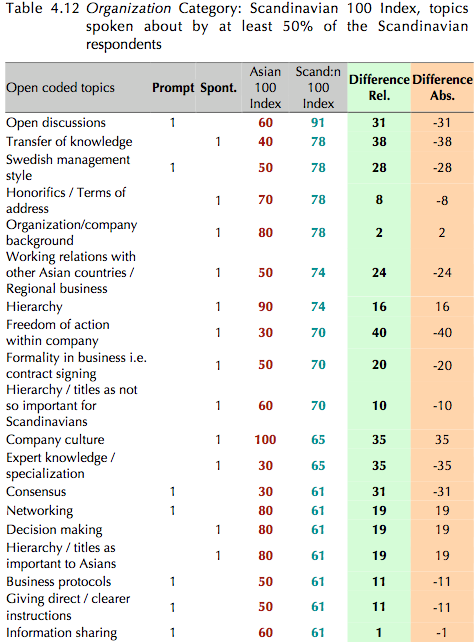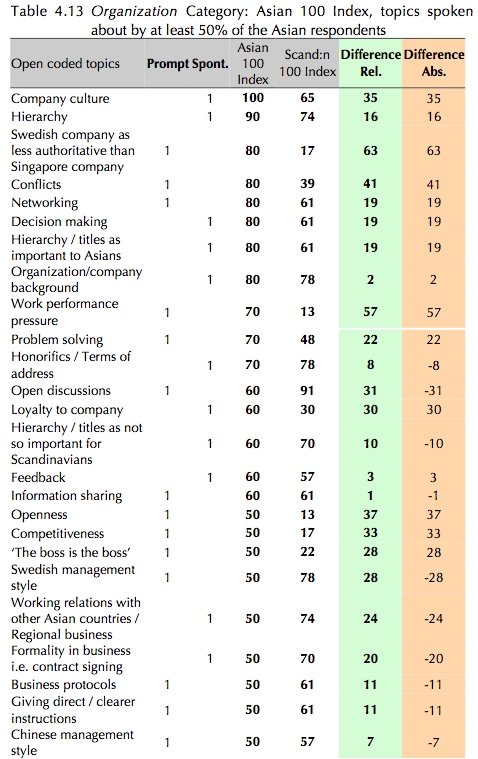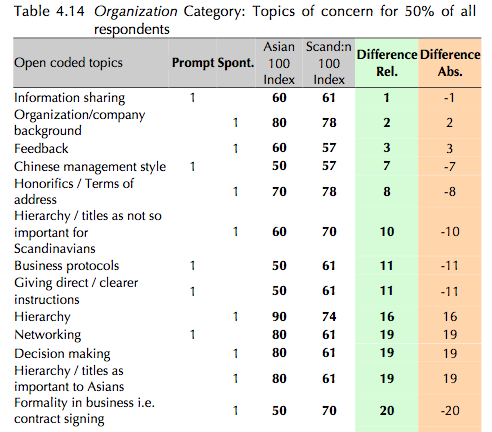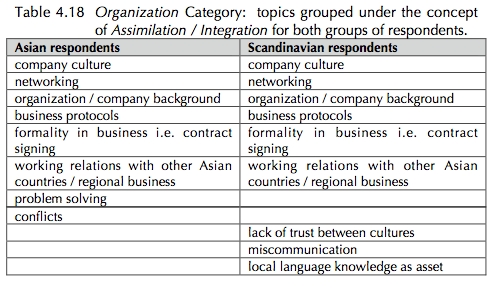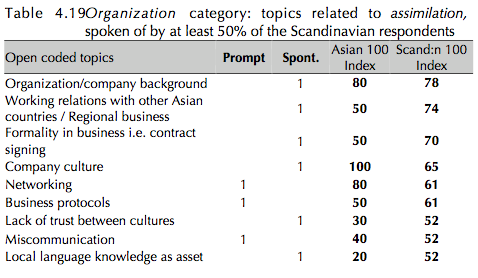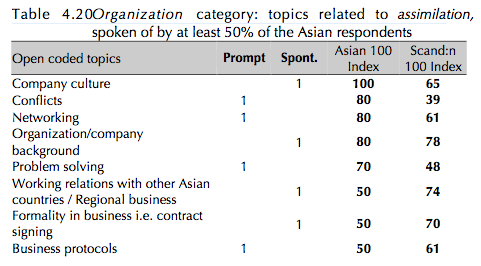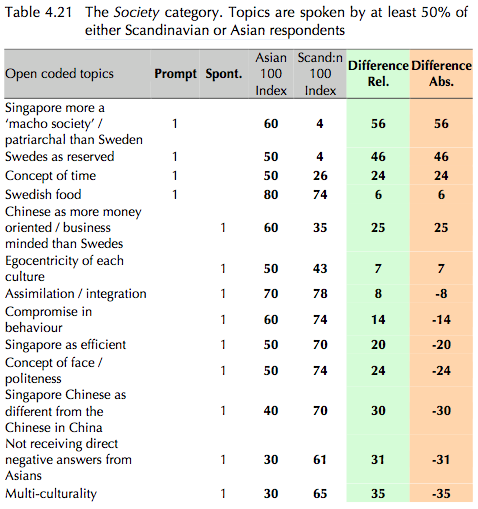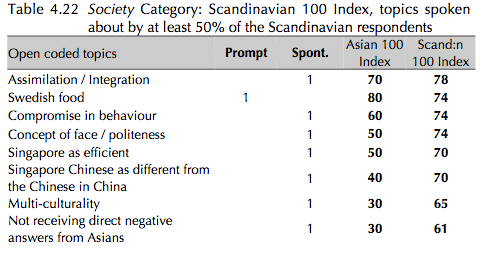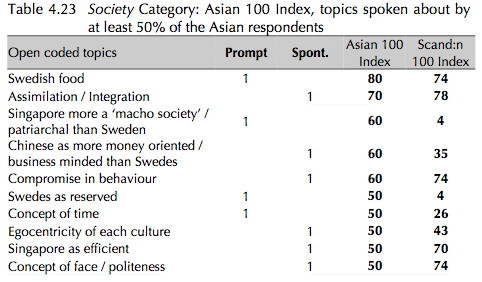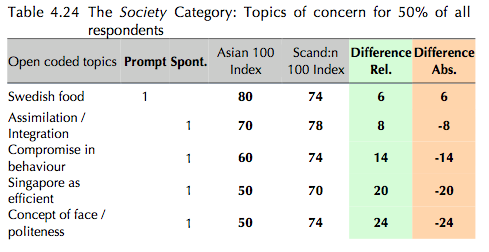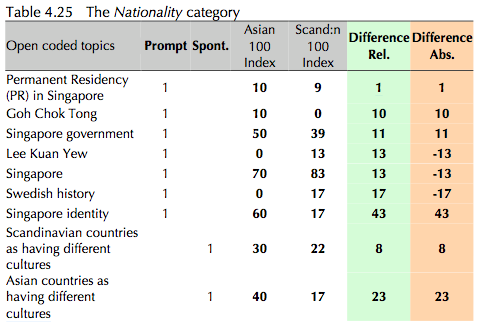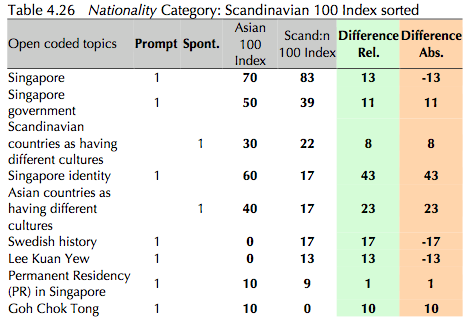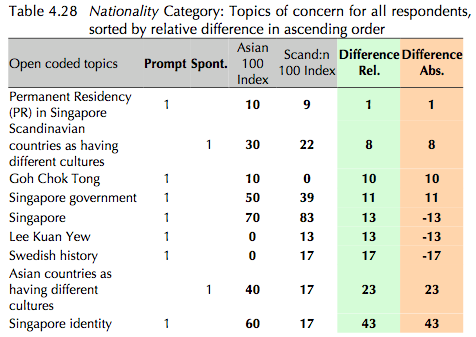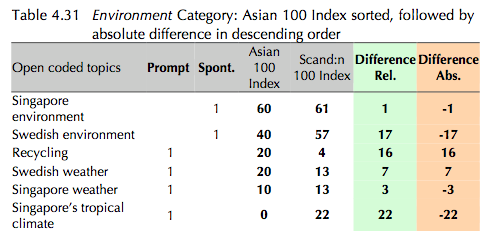As mentioned in Chapter 3, the purpose of applying grounded theory coding procedures (Strauss and Corbin, 1998) in this study is two-fold. The first is to use grounded theory coding procedures as a data management tool, to sort the 540 pages of transcribed interview data into topics spoken about by the respondents. These topics are grouped into larger, more manageable categories. The labels of the categories such as Individual, Family and Social, Organization, Society, National and Environment reflect topics that radiate from the individual as a respondent and how they view themselves in relation to Others and to the larger society. The second is to use the grounded theory coding procedures as a way of making more stringent the manner in which topics and subsequent texts will be chosen for the purpose of discourse analysis. The discourse analysis of the texts will be presented and discussed in Chapter 5.
This chapter will present the results of the applied grounded theory coding procedures. The presentation of the results will begin with an overview of the categories, and their most relevant topics are also presented and discussed.
4.1 Overview of Categories
Briefly mentioned in the previous chapter, the 252 coded topics were sorted into 6 broader categories that radiated outwards from the Individual as the “starting point” or centre of a socio-cultural fabric. Topics belonging to the Individual category were then followed by other topics that were categorized into the Family and Social, Organization, Society, Nationality and Environment categories. Each category can be seen as encompassing topics in the previous categories, since topics relevant to the larger, outward radiating category are also relevant to the smaller categories closer to the individual. For example, topics in the Family and Social would also be relevant to the Individual category since families are made up of many individuals.
Tables 4.1 to 4.3 illustrate the 6 categories, sorted by percentage of topics within each category. The tables also indicate whether the topics were spontaneously spoken of, i.e. the topics were brought up by the respondents themselves or if they were prompted topics, i.e. the topics were brought up by the interviewer.
Table 4.1 shows the Organization category as the category that contains the most topics with 45% of the all topics coded under that category. This is followed by the Society and Individual categories that contain the next largest numbers of topics, with 30% and 13% respectively.
Table 4.2 shows that the respondents spoke most spontaneously when it came to topics that belonged to the Individual category, or topics that revolved around themselves as individuals. This is followed by the category of Society and Organization with 53% and 44% of spontaneous topics respectively.
Table 4.3 shows that prompted topics for the respondents fell mostly in the category of Nationality with 78% of the topics being prompted. This category included topics that pertained to the respondents’ nationalism and their relations to their respective countries, its politics and questions relating to their feeling of national identities. Prompted topics were also abundant in the two categories of Family and Social and Environment with 74% and 67% respectively, indicating that the respondents as a whole did not readily offer information for topics in these categories, possibly because family and their individual social lives make up part of their private domains.
The tables below are presented with a relative and absolute difference index, the greater the relative difference in number, the greater the difference in ‘concern’ or interest in topic between the two groups of respondents.
The absolute difference is indicative of which group of respondents showed more interest in the topic, whether it is the Asian or Scandinavian respondents. A negative absolute difference usually indicates that the interest for the topic is in the direction of the Scandinavian respondents i.e. more Scandinavians were interested in that particular topic and therefore spoke more about it than their Asian counterparts; whilst a positive absolute difference shows that the interest for the topic lies in the direction of the Asian respondents i.e. more Asians were interested in the topic. The 100 Index which is also shown in the subsequent tables, as mentioned in the previous chapter, makes the two groups of respondents comparable in terms of numbers as there are 23 Scandinavian respondents and 10 Asian respondents.
The 6 categories will be presented in the following order that begins and radiates from the Individual:
1.The Individual category
2.The Family and Social category
3.The Organization category
4.The Society category
5.The National category
6.The Environment category
In each category description, the presentation of data is then sorted according to four different ways or points of view, which are:
In each category description, the presentation of data is then sorted according to four different ways or points of view, which are:
i. data sorted according to prompted or spontaneous topics – the function of which is to allow easy viewing and grouping of topics that were spontaneously brought up by the respondents and which topics needed prompt.
ii. the Scandinavian respondents’ point of view sorted according to the Scandinavian 100 Index – the function of which is to allow topics most salient to the Scandinavians to be revealed and grouped together.
iii. the Asian respondents’ point of view sorted according to the Asian 100 Index – the function of which is to allow topics most salient to the Asian respondents to be revealed and grouped together.
iv. topics of equal interest, i.e. topics that draw near equal interest from both groups of respondents and spoken of by at least 50% of both groups of respondents – the function of which is to gather, sort and reveal topics that were of most interest to both groups of respondents.
4.2 Categories: presentation and discussion
- the Scandinavian respondents’ point of view sorted according to the Scandinavian 100 Index – the function of which is to allow topics most salient to the Scandinavians to be revealed and grouped together.
- the Asian respondents’ point of view sorted according to the Asian 100 Index – the function of which is to allow topics most salient to the Asian respondents to be revealed and grouped together.
- topics of equal interest, i.e. topics that draw near equal interest from both groups of respondents and spoken of by at least 50% of both groups of respondents – the function of which is to gather, sort and reveal topics that were of most interest to both groups of respondents.
Categories: presentation and discussion
4.2.1 The Individual category
The Individual category consists of 33 topics that pertain to the person where the individuals are encouraged to speak about themselves or did so spontaneously. This category contains 76% of spontaneous topics, which makes this category significant in containing the highest number of spontaneous topics amongst all categories. Appendix 4A contains the full table on the Individual category and the various ways in which the data is sorted.
4.2.1.1 Prompted / spontaneous topics sorted
Table 4.4 below (see also Appendix 4A.3) shows topics spoken about by at least 50% of either group of respondents in the Individual category. The topics are sorted according to prompted and spontaneous topics and then according to relative difference in descending order. This shows not only the spontaneous and prompted topics but it shows the topics with greatest difference in interest from each group of respondents, with the topic of greatest interest difference shown first in Table 4.4.
There are 8 prompted topics and 25 spontaneous topics in Table 4.4. Amongst the prompted topics, the Scandinavian respondents seemed to discuss getting a broader vision and their sense of history much more than their Asian counterparts. These two topics attracted less than 50% of the Asian respondents’ interests with an Asian 100 Index of 40 and 10 respectively. The Asians preferred talking more about hawker centres and food courts, which are everyday features of Singapore living and eating out in Singapore. These two topics likewise attracted very little attention from the Scandinavian counterparts, with Scandinavian 100 Index of 9 and 4 respectively. Spontaneously, the Asian respondents also spoke about their favourite local (Singapore) food.
Most of the spontaneous topics can largely be said to revolve around the individual and their point of view on culture. Whether it’s living in a foreign country or encountering a different culture in their working environment and learning about the new environment and culture in terms of humour or food and knowledge of each other’s language, traditions etc.
Text examples 4.a and 4.b below lend examples of transcripts that would fall into the Individual category. These first two text examples will show how the open coding procedure adapted from Strauss and Corbin (1998) has been applied to the data. A description of the open coding procedure and more examples of the coding process can be found in Chapter 3, section 3.4.3. Text examples 4.c onwards in this chapter will be shown without the coding to improve text readability.
Food as a topic also ranks as one of the most interesting topics for both groups of respondents (as shown in Tables 4.5 and 4.6), with more than 50% of the respondents speaking about food. In example 4.a, a Swedish respondent G, speaks of his/her own experience with the kinds of food that they like / dislike or miss in Singapore and in Sweden:
Example 4.a
$G: …food [in vivo code] [“food”] is excellent…black peppar crabs…i love it i love it / even the chilli crabs / and er no i mean i miss sweden / the normal hawker centre [in vivo code] [“hawker centres”] just walk in and buy food for two three dollars it’s perfect / quick and er / good / that i miss in sweden / there you can just buy the hotdog
…i can buy a can of caviar / knäckebröd you know / crispy bread [non in vivo code] [“Swedish food”] i can buy here at ikea / some special items i miss of course / but if i have to choose it’s of course / i love asian food [in vivo code] [“Asian food”] / not really fond of indian food but singaporean style chinese food thai food japanese food / fantastic [non in vivo code] [“food”]
In example 4.b, a Chinese Singaporean respondents L lends his / her point of view on Swedish food and his / her experience of being in Sweden for the first time:
Example 4.b
$L: …i don’t mind the meatballs / but if you asked me to survive on swedish food [in vivo code] [“Swedish food”] / i don’t think i can / i don’t like herring / i don’t like cheese [non in vivo code] [“Swedish food”] / i’m not a cheese person / unfortunately / the first time i got a culture shock [in vivo code] [“culture shock”] was from this trip / i went to sweden / a leadership seminar [non in vivo code] [“get a broader vision”] / blur lah first time / everything first time very blur / then go there they gave me / spinach soup / but it was cold / then i said / oh gosh / how to drink ah / but i was not the only one that is resistant to it / the guy from new york also the same thing / american / i said / why you not drinking / i asked him why you not drinking / cannot drink / two of us / you drink first / you drink first / but it was actually rude of us / so i tried one spoonful / okay / thank you very much / cannot take it / they love cold food you know /
…i think to a chinese / the soup must be hot right / double boiled like that / i don’t know how to eat like herring / they love herring / maybe to them it’s a delicacy to them / but i cannot leh / very salty [non in vivo code] [“Swedes / Europeans vs Chinese / Asians vice versa”] / i haven’t got used to it / not yet [“culture shock”] / very normal food / can / fine / like salmon / ordinary food can / i’m not used to reindeer / tougher than beef [“Swedish food”] / i don’t think i finished it / then i was like pretty poor thing / the first trip i went there / i practically ate nothing / i ate a lot of bread
The above text examples cover topics such as food and Swedes / Europeans vs Chinese / Asians and individual experiences of going abroad or living in Singapore.
4.2.1.2 Scandinavian respondents’ point of view
Appendix 4A.2 shows all topics from the Individual category sorted according to the Scandinavian 100 Index. Table 4.5 shows a delineated version of topics where 50% or more of the Scandinavians have spoken of the topic where the topics seem to reflect the Scandinavian respondents’ point of view and what they deemed interesting to speak about. Table 4.5 is sorted according to the Scandinavian 100 Index, followed by the absolute difference in descending order. The topics of greatest interest to the Scandinavians should show in the top rows.
With regards to topics brought up spontaneously by the Scandinavian respondents, their foremost concern or interest seems to be on the topic of language as a barrier, with a -60 absolute difference. The topic of language as a barrier is further explored in Chapter 5 in relation to language as an important aspect to doing business and important for socializing outside of the office.
The next spontaneous topics for the Scandinavians include the individual as adventurous, no language barrier (not all of the Scandinavian respondents thought they had a problem with language in Asia, in particular, Singapore) and knowledge of local traditions / culture, with absolute difference numbers of -25, -25 and -24 respectively. Text example 4.c lends an example of a Swede, M, who speaks about his adventurousness and wanting to explore, as a reason to be in Singapore. Further down in the conversation, M mentions the language barrier and makes reference to his knowledge of local Chinese traditions when it comes to relationships and expected social behaviour:
Example 4.c
$M: …in sweden / everyone is swede / so your social circle and everything is pretty limited / i mean because everyone in sweden is more or less swede / they’ve grown up in sweden / they have their background in sweden / they’ve got all their friends there / and they have you know / they don’t come in with any new stuff / i mean here you have friends who are indian / chinese / malay / a lot of other people from europe and the western world as well / so you know the diversity here is so much bigger which i think is fun /
… i mean my girlfriend for example is very westernised and her parents / even though her mom doesn’t speak any english at all / her dad is also i would say / you know / for being a chinese family / even comparing to a singaporean family … extremely you now / open and liberal about anything … we stay together / when we go back to her parents / we stay in the same room / there is nothing that is you know / going against traditional values / nothing like that /
As for prompted topics of interest, the main topic of interest for the Scandinavian respondents was that of getting a broader vision, much like Example 4.c above with M telling of his reason to work abroad in Singapore. Swedish respondent, G also tells of how working abroad has contributed to a broadening of his horizons and personal development in text Example 4.d. The topic of self-identity is also touched upon in both example 4.c and 4.d.
Example 4.d
$G: … i am swedish i will always be a swede but erm / i mean you pick the best thing out of each country / i’ve been living in france and in germany and in sweden and you pick something good in each country to make it your own / in a better mix / i have a brother still living where i was born in sweden and when we meet / i can feel that / i don’t say i am better than him but i / i know a lot more about people … when you return you have opened your eyes /
These spontaneous and prompted topics from the Individual category, from the Scandinavians’ point of view reflect their everyday lives and experiences that they have gathered, of living and working in a foreign country. Their experiences include witnessing a new culture, new environment and new types of food. The topic of getting a broader vision for example, is one of top interest to Scandinavians possibly because all interviewed have worked overseas for some time.
4.2.1.3 Asian respondents’ point of view
Appendix 4A.1 shows the full category sorted according to the Asian 100 Index. Table 4.6 shows topics where at least 50% of the Asian respondents spoke of the topic, sorted according to the Asian 100 Index, followed by absolute difference in descending order. These topics would reflect what the Asian respondents found most interesting to talk about within the Individual category.
The largest absolute differences for the Asian respondents were found in topics that were brought up spontaneously. The topic of most interest for the Asians, with an absolute difference of 77 is the topic of favourite local (Singapore) food. They also spoke interestedly about accommodating the Other, in the topic, agreeing to do it the ‘Other’s’ way. This topic is also explored further in Chapter 5, when investigating strategies within the organization for assimilation and integration between the Scandinavians and the Asians.
Text example 4.e shows a Chinese Singaporean L, speaking about honorifics within the organization and thus touching implicitly upon the concept of hierarchy within the organization. L begins by comparing Swedish bosses with local bosses, by saying “they are more informal”. It also shows how the locals accommodate a foreign hierarchic system (in this case, Swedish) in terms of address.
Example 4.e
$L: they are more / i would say / more informal / you know / they will tell you you can call me by my name / unlike local bosses right / you normally go like mister so and so / but i think things have changed / even i think for some local banks / they are also trying to get / become more informal / but i think / uhm / the formality is somehow is still there you see / here in this bank / in the beginning we started calling so and so mister so and so / then came one managing director / call me ralph or call me walter so that’s when we started / from then on / any new even m d we start calling the guy by the name / yah first name on the first day
Another text example from a Chinese Singaporean respondent, C who touches upon the subject of learning to do things the Others’ way and learning in general:
Example 4.f
$C: you appreciate it / but i think you have to start understanding their perspective / it took me quite awhile to understand this as well / they do have a very social mindset / you know / when they do things they look at broader issues like the environment and all / unfortunately if you go to indonesia / they don’t care about the environment / the first thing they say is / okay / i put this in / how much money will it save me / they are very economy driven / but / you know / then our swedish colleagues will come and will package proposals and they will look at the environment / they will put a lot of things that / that / if indonesia were more developed / would certainly be very meaningful / but you’re dealing with companies that have not reached that level / they’re still probably with bread and butter issues / so there are some of these that we haven’t adjust and adapt / so that’s the reason why they have / local operations / if not / you can easily send people /
… but over time / we start to understand each other a little bit better / i guess after three years / the turning point is like a year and a half / when they start to say okay / you see before this they had a swede / and the swede was always running this operation since it started / so / so a swede / will never be local / he can live local / he can behave local but he will not think local / and certainly in terms of some ways / there are certain cultural issues / that they will find difficulty dealing with / whereas we are local / just like in the same way we have certain swedish habits that we will never be able to adjust to / and that is part of the balance you have to learn to understand and respect each other’s positions
In the above example, although C is a Singaporean respondent, he identifies more with ‘Swedes’ by using the word ‘we’, whereas the Indonesian operation is more ‘other’ or ‘they’.
Other topics of interest to the Asian respondents are knowledge / interest in Singapore English, with absolute difference of 50 shows that it is a topic that is of little interest to the Scandinavian respondents. Of the lesser interesting topics to the Asians is the topic of knowledge of local traditions / culture. A possible reason for this could be that respondents working in their home country already have an implicit / tacit knowledge of their own traditions and culture, so that such entities are something ‘taken for granted’ rather than something that needs to be learned.
4.2.1.4 Topics of equal interest to both Scandinavians and Asians
While Tables 4.5 and 4.6 highlight topics of interest particular to each group of respondents, Table 4.7 shows topics sorted to indicate topics that are of common interest for at least 50% of the respondents in both groups. These topics in Table 4.7 are sorted according to relative difference in ascending order. The topics of interest to both groups will be shown in the top rows of Table 4.7.
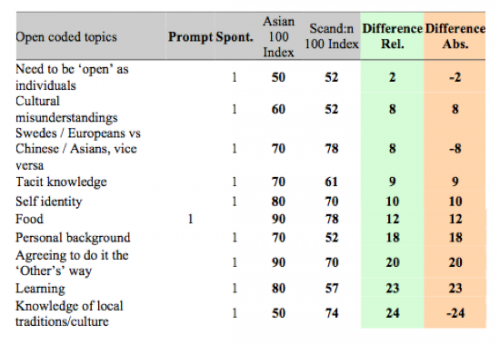
Table 4.7 Individual Category: Topics of concern for 50% of all respondents (Cordeiro-Nilsson 2009: 133)
The only occurring prompted topic in Table 4.7 is the topic of food, where both groups of respondents seemed interested in the topic of food, although the Asian respondents showed slightly more interest in that topic. All topics in general seemed to have a fairly small relative distance not exceeding 24. The topic with most ‘common ground’ with the smallest relative difference was the topic need to be ‘open’ as individuals, followed by cultural misunderstandings with 2 and 8 as relative difference respectively.
Example 4.f lends a good example of text that covers whether overtly or implicitly, topics such as the need to be ‘open’ as individuals, having an accommodating disposition when working cross-culturally and negotiating cultural differences. Example 4.g is a text example from a Swedish respondent, also C, who took active steps in overcoming cultural misunderstandings and encouraging an open environment within the organization with a third party communications consultant. It touches on both topics of the need to be ‘open’ as individuals and cultural misunderstandings:
Example 4.g
$C: …that’s one of the big differences i see / people are more willing to share information in sweden / we feel that they should be equally involved and share in group discussions / you have to / it takes a bit of time and you can’t be too straight forward / you have to go around them and try to find out / i use others of course also / i mean er / especially the chinese / it’s easier for the chinese to communicate with each other / but they find us very rude / yah / because we are so straight forward / we had an interesting after / we had quite a lot of differences when we first started / rather big differences between us / it was only three but even if you set up a project in sweden with three companies / we have problems / because there’s a culture in every company that is almost as strong as national culture / on top of that here / we had one swedish one chinese and one singaporean company ah / and in the office we have some <ang mohs> british guy and one from new zealand and of course we have the indians and the malays / so it was quite difficult / so after awhile we organized a workshop / i used the consultant here in / we hired a consultant / there was some / i don’t remember now / but it was on cross cultural issues / so we met with them for one day / and they made up a program and we started talking / and all of a sudden / i was really amazed i must say / because all of a sudden one of the chinese guys in the office / he opened up so to speak ah / and then he start to say what he meant / which i never had expected i must say / so he explained to us swedish that we were extremely rude ah / and we were so straight forward / so he was quite angry at us…and after a while it boiled down / one of the key issues / is this yes and no business / i mean like / one of the swedes he came and asked him to fix the telephone line / that was his job ah / so the swede asked him / can you be ready on monday / and of course he said yes / but he didn’t mean it should be ready on monday of course / and the poor swede he thought okay / it will be ready on monday / so when it was not ready on monday / he went back to him and well / more or less shouted at him / yah and er / and then he explained in the meeting then that / he didn’t want to disturb the swede by telling him all the problems fixing the telephone so it would need to take about a week / but er / i mean he wanted to please him / wanted to tell him he would fix it of course / i mean / he’s like okay i’m doing my best / but for us in sweden / it’s yes or no / yes is yes / no is no / there is nothing in between / but for me i had exactly the same experience in south america /
@ <caucasians>
The topics from Table 4.7 that are mostly spontaneous in nature, indicate a ‘common ground’ for both groups of respondents. These topics could possibly lead to indicators of strategies of assimilation or adjusting to the Other when working / living together and they can be further crossed referenced and grouped together for further exploration / analysis. The spontaneous and ‘common ground’ characteristic of these topics can be discussed under the broader heading of Assimilation and Integration, that include:
- Food
- Learning
- Agreeing to do it the ‘Other’s’ way
- Tacit knowledge
- Cultural misunderstandings
- Need to be ‘open’ as individuals
- Swedes / Europeans vs Chinese / Asians, vice versa
- Knowledge of local traditions/culture
The above topics that could reveal or lend insight into the respondents’ approach to integrate with the larger society, cover areas that are outside of the organization. The concept of assimilation and integration within the organization, is further explored in Chapter 5.
4.2.2 The Family and Social category
The Family and Social category consists of topics that pertain to the respondents’ immediate social circle where they speak (mostly) about familial and social relations within the private domain, for example, if they speak of their parents or of their spouses and children. Topics such as how they spend time after working hours socializing is also found in this category. Appendix 4B shows all topics under the Family and Social category, with the data sorted in various ways.
4.2.2.1 Prompted / spontaneous topics sorted
This category has 15 topics altogether, which is 6% of the distribution of the 252 main topics. Of these 15 topics, 11 or 74% are prompted topics and 4 or 26% are spontaneous topics, the greater number of prompted topics perhaps indicating that the spheres to which the topics belong are more private rather than public information.
Table 4.8 shows topics in the Family and Social category, sorted according to prompted and spontaneous topics and then according to relative difference in descending order.
The prompted topic with the largest relative and absolute difference, – 45, in the direction of the Scandinavian respondents, is the topic on expatriate (personal) friends. This is paralleled by the Asian respondents speaking of their (Singaporean) personal friends, with an absolute difference of 33 in the direction of the Asian respondents. The Scandinavians also spoke more about their family background; most of them described themselves as coming from a middle class family or an ordinary / not rich family, with a -33 absolute difference, while the Asian respondents spoke about Singapore men and children, with 21 and 18 absolute differences respectively.
All four spontaneous topics in this category have a negative absolute difference, indicating that it was the Scandinavian respondents who had opened up more during the interview and were more willing to give information on their family and social life without prompting from the interviewer. The topics include expatriate living (-54 absolute difference), Swedes and Singaporeans socializing (-22 absolute difference), mistaken name calling (-22 absolute difference), which also occurs within socializing contexts and expatriates with a local woman (-16 absolute difference), for those who are with a local woman or those who have friends who are dating / married to local women. These four topics seem to broadly reflect their experience of their expatriate status and living in Singapore.
4.2.2.2 Scandinavian respondents’ point of view
Appendix 4B.2 show all topics in the Family and Social category sorted according to the Scandinavian 100 Index. Table 4.9 shows topics from the Family and Social category spoken by at least 50% of the respondents. The data is sorted according to the Scandinavian 100 Index, followed by the absolute difference in descending order.
The topic of expatriate living was what the Scandinavians were most interested in speaking about, where they spontaneously talked about Swedes and Singaporeans socializing. Less spontaneously, they talked about personal friends and family. Example 4.h lends a text example of a Scandinavian respondent J, who talks about his experience as an expatriate in Singapore and his socializing experiences with the locals. J’s segment of speech possibly touches on all topics listed in Table 4.9.
Example 4.h
$J: …i mean / it’s not easy to be an expat out here / we’ve been here a long time and we don’t have any singaporean friends after fifteen years / i have friends in the hash house harriers / we have met up / i have twice i think during fifteen years / been at a singaporean house / that’s horrible / that’s really sad / but that’s how it is / singaporeans don’t want to have you as a friend / that’s my experience that er / locals don’t want to socialise with expats / local womens yes no problem / but local families / they’re not involved / you just see them here to do work / to earn money and nothing else / you don’t see them much otherwise // but don’t misunderstand that / i see that the younger generation / those younger / they have no problems with that / but er / the older chinese / the malay but mostly older chinese / they have absolutely no interest in socializing with expats / that’s really sad though / it’s very sad / i’m married to a foreigner myself so i mean / but er / as you can see it works probably the same in sweden / swedes are very stiff / they are not really / okay if you’re married or sambo with a swede / no problems right / but if you’re there by yourself / or there as a refugee or a political one or whatever / very hard
The main point in J’s discourse is that it is difficult being an expatriate in Singapore since not many Singaporeans wish to socialize with expatriates outside of the office, or beyond ‘office hours’. J’s point of view somewhat concurs with L’s point of view (in Example 4.j below) on how she chooses not to socialize with colleagues after work due to wanting to be with her children and family.
4.2.2.3 Asian respondents’ point of view
Table 4.10 show topics the Family and Social category, spoken of by at least 50% of the respondents, sorted according to the Asian 100 Index, followed by the absolute difference in descending order. The full table sorted according to the Asian 100 Index can be found in Appendix 4B.1.
That there are no spontaneous topics in this category in the above table, implies that the Asian respondents were not too ready to spontaneously talk about their private domains such as family and friends. In example 4.j, An Asian respondent L for example, answers the question “Do you go often out with your colleagues after office hours?” in the following few lines:
Example 4.j
$L: i do / but not often / because i have a family / so i’m very very committed to my family / my son is twelve / my daughter is eight years old / so i’ve got two and they’re still very demanding / so have to rush home every night / so i’m trying to < jaga > / i’m still trying to balance my work life and my family life / so not much time to go out ah / but i still make an effort sometimes if they have dinner or let’s say if we have new colleagues or colleagues going off / office functions all this lah
@ <look after>
Although L’s point of view is individual, it does concur with J’s point of view that Singaporeans in general, do not socialize outside of office hours. That the two groups, as expatriates and locals, do not socialize outside of work is also found in Example 4.n in section 4.2.3.4 below, when respondent B speaks about networking and having good friends. The friends that B has in Singapore is never quite the same as those he has in Sweden.
4.2.2.4 Topics of equal interest to both Scandinavians and Asians
From Tables 4.9 and 4.10, the two groups of respondents seem to have only one topic in common, with at least 50% of respondents from both groups speaking about family after some prompting from the interviewer. The ‘common ground’ status of this topic has a relative difference of 1.
As reflected in the summary Table of this category and again reflected in Tables 4.9 and 4.10, the family and social category contains topics revolving around the respondents’ social life, outside of working hours. The most common things for the Scandinavians to speak about are living as expatriates and socializing with Singaporeans whilst the Asians spoke mostly on the topic of family. Example 4.j seemed somewhat to confirm the Swedish respondent J’s feelings that Singaporeans in general may not wish to or may not prioritize socializing with expatriates all that much outside of organization hours since what is of priority to the Asian respondents are spending time with family.
4.2.3 The Organization category
The Organization category is the largest of all the 6 categories, comprising 45% of the overall data or 112 of the 252 topics. Of the 112 topics in this category, 56% or 63 topics are prompted and 44% or 49 topics are spontaneous topics. Appendix 4C presents all topics occurring in the Organization category and the tables found in Appendix 4C presents the various ways the data is sorted. As the Organization category contains many topics, the following sections below will show topics spoken of by at least 50% of either group of respondents, sorted in various ways.
In the next chapter, text examples that reflect the more salient topics from the Organization category will be further analyzed using the linguistic framework outlined in chapter 3.
4.2.3.1 Prompted / spontaneous topics sorted
Table 4.11 and Appendix 4C.4 shows a delineated summary of the Organization category. The full table of topics in this category sorted according to prompted / spontaneous topics can be found in Appendix 4C.3. Topics shown in Table 4.11 are those with at least 50% of either the Scandinavian or Asian respondents having spoken of the topic. These are sorted according to prompted and spontaneous topics and then according to relative difference in descending order.
Table 4.11 contains almost an equal number of prompted and spontaneous topics, with spontaneous topics being only 2 more than the prompted topics, with 16 prompted and 18 spontaneous topics. The prompted topics mostly included that of management styles and what the respondents thought of the management styles within the organization. The distribution of 8 negative and 8 positive absolute differences within the prompted topics show that both groups of respondents shared an equal interest in responding to the questions raised by the interviewer, with each group having an equal number of topics which interested their group. Prompted topics with a small absolute difference include information sharing, Chinese management style, giving direct / clear instructions and business protocols. These topics have almost equal attention and interest by both groups of respondents, with absolute differences of -1, -7, -11 and -11 respectively, although the negative absolute differences indicate that slightly more Scandinavians had spoken of these topics than Asians. These topics seem to reflect / contain aspects of communication and elements of hierarchy.
Within the spontaneous topics, there are 6 topics with a positive absolute difference and 12 topics with a negative absolute difference, which indicate that it is the Scandinavians as a group that have used more spontaneous topics (in their interviews) than the Asians, in that they went beyond the interview questions and brought up topics of interest of their own accord and spoke about topics that interested them as a group. The spontaneous topic with the largest negative absolute difference of -47 is Singaporeans as lacking initiative. This is followed by the topics of freedom of action within company, transfer of knowledge and expert knowledge / specialization with -40, -38 and -35 respectively. The first two topics discussed by the Scandinavian respondents on initiative and freedom of action within the organization seem to reflect their perception of a difference of management styles and working expectations when working with their Asian colleagues / employees; while the other two topics on knowledge transfer and expert knowledge seem to reflect the reason for the Scandinavians’ presence in Asia.
Spontaneous topics containing a small positive relative difference of 2 and 3 include talk about organization / company background and feedback. This indicates that while both groups showed an equal interest in talking about these topics, the positive relative difference indicates that slightly more Asians spoke about this topic. Small negative relative differences of -8 and -10 include hierarchy / titles as not so important for Scandinavians and honorific / terms of address, topics that were spoken about only slightly more by the Scandinavians than the Asians.
The following sections will go into each group’s point of view and topics that specifically interested the two groups.
4.2.3.2 Scandinavian respondents’ point of view
Table 4.12 and Appendix 4C.2 shows the topics within the Organization category sorted according to the Scandinavian respondents’ point of view, according to the Scandinavian 100 Index in descending order, followed by relative difference in descending order. The Table shows topics that were spoken of by at least 50% of the Scandinavian respondents.
The two most interesting prompted topics for the Scandinavian respondents were open discussions and the Swedish management style, with more than 70% of the Scandinavians speaking of these topics, after which, spontaneous topics seemed to be of greater interest for the Scandinavians.
Spontaneous topics generally seemed to center around the individual and his / her immediate surrounding in the organization such as talking about their organization / company background, how people address each other within the office in terms of honorifics, and how the organization is hierarchically structured etc.
Generally, these topics can be said to reflect a broad outline of the Scandinavian (mostly Swedish) management style of working. The topic of work performance pressure which features quite high on the Asian respondents’ list of interesting topics for example, does not seem to feature as part of the Scandinavian working style or the topic does not appear as a pressing issue for the Scandinavian respondents, featuring a Scandinavian 100 Index of 17 compared to the Asian 100 Index of 70.
4.2.3.3 Asian respondents’ point of view
Table 4.13 and Appendix 4C.1 shows topics that reflect the Asian respondents’ perspective, sorted according to the Asian 100 Index in descending order, and then by relative difference in descending order.
There are 5 prompted topics that seem to be most interesting for the Asian respondents with more than 70% of the respondents speaking of these topics, including Swedish company as less authoritative than Singapore company, conflicts, networking, work performance pressure and problem solving. These topics seem to reflect a comparative mode of talk where the Asian respondents talk about the difference between the working styles between the Swedes and Singaporeans, the work pressures that they feel and how they may manage problems at work, as an everyday work experience.
Spontaneously, more than 70% of the Asian respondents seemed to also discuss their organization culture, hierarchy within the organizations, honorifics and how they address each other at work, networking processes and decision making processes.
4.2.3.4 Topics of equal interest to both Scandinavians and Asians
Table 4.14 and Appendix 4C.5 shows topics of equal interest to both Scandinavians and Asians, where 50% or more of either group spoke of the topic. These topics in Table 4.14 are sorted according to relative difference in ascending order. Topics of salient interest for both groups of respondents are those with small relative differences, which are found at the top rows of Table 4.14.
Topics with comparatively small relative differences of 10 and below, include:
- Information sharing
- Organization/company background
- Feedback
- Chinese management style
- Honorifics / Terms of address
- Hierarchy / titles as not so important for Scandinavians
A common characteristic of the above topics, and perhaps generally from Table 4.14, is that the topics seem to exhibit characteristics that would allow them to be grouped into two larger concepts, that of (i) hierarchy and (ii) assimilation and integration.
Hierarchy as a concept refers broadly to how the power within the organization is structured, distributed and shared. Assimilation can be defined as a process, “a decline and at its endpoint the disappearance of an ethic / racial distinction and the cultural and social differences that express it” (Alba and Nee, 1997:863), it refers to the giving up of one’s cultural heritage and roots so as to adopt the cultural heritage of the Other, in order to be absorbed into the dominant culture (Petersson, 2006). Integration is also a process, but one that differs from assimilation in that one gets to keep one’s socio-cultural heritage, sharing one’s own cultural knowledge with the dominant culture, thus becoming an incorporated part of the dominant culture with recognized differences (Goldmann, Pedersen and ∅sterud 1997; Petersson 2006). Some scholars have viewed the process of integration as a facet of assimilation, where integration is arrived at prior to assimilation (Roy, 1962).
Open discussions Company culture
While assimilation and integration are relatively different concepts, the concepts were grouped together into a single topic, for coding and subsequently text sorting purposes. The differences in these concepts will be analyzed linguistically, in accordance to how the respondents spoke about their experiences in becoming part of the dominant culture. And for the moment, they will be referred to as one unit, which is assimilation / integration.
These topics of hierarchy and assimilation / integration, are spontaneous topics in themselves that occur within the Organization and Society categories, with the topic assimilation / integration having an absolute difference of 9.
With the help of Table 4.14 in showing up the most salient groupings of topics, the topics of hierarchy and assimilation / integration can be explored further in terms of cross-referencing and the building of its concepts from more topics from Table 4.11. The following sections will discuss the cross-referencing and the relating of other topics in a similar vein from Table 4.11 to hierarchy and assimilation / integration in order to form larger concepts.
Hierarchy
Whilst Table 4.14 was useful in showing the saliency of the groupings of the topics, it is more useful to group topics from Table 4.11 so that a more comprehensive overview of topics related to hierarchy can be obtained. Gathering all topics from Table 4.11 that can be related to the concept of hierarchy within organizations, Table 4.15 shows the groupings of topics from Table 4.11, into the larger concept of hierarchy. The topics are grouped according to the Asian perspective i.e. what the Asians tend to talk about when talking about hierarchy and the Scandinavian perspective i.e. what the Scandinavians talk about when talking about hierarchy. The blank sections in this table indicate a non-corresponding concept in either the Asian or Scandinavian group of respondents for that particular concept.
Hierarchy: the Scandinavian perspective
Table 4.16 presents topics on hierarchy spoken by at least 50% of the Scandinavian respondents. The dark grey print under the open coded topics column in Table 4.16 indicates topics that have also been spoken of by more than 50% of the Asian respondents. The three topics of freedom of action within [the] company, consensus and Singaporeans as lacking initiative in black print indicate topics spoken of only by at least 50% of the Scandinavian respondents. Both topics are notably spontaneous, from the Scandinavians, and rank fairly low on the Asian 100 Index with 30 and 10 respectively. That the Asian respondents hardly talk about these topics could be due to that they may be quite unaware of any lack of freedom within the organization, Singapore having a more authoritarian working model than Sweden for example (Hofstede and Bond, 1999; Hofstede, 1980).
Employees taking their own initiatives is also not always appreciated by Chinese Singaporean leaders as they work on a centralized decision making model, as compared to the Swedes (Jönsson, 1995).
A good text example that spans several topics related to hierarchy and covers hierarchy as a concept from a Scandinavian point of view, comes from Swedish respondent M who talks about restructuring the organization and how the employees were encouraged to take on more responsibility, get creative, have open discussions and expand their horizons:
Example 4.k
$M: … 1998 i was appointed g m for asia / and at that point in time / there were more or less nine hierarchic title levels in the office / i mean everything from junior clerk / clerk / senior clerk / junior officer / officer / senior officer / so nine sort of title levels and nine / all levels also had a number of value of annual leave days / as an officer you had one more day than a junior officer / despite the fact that other swedes have been g ms here / i don’t know why they didn’t find interest to do something about it / but in the office back home / we have three / so i changed that to three / which mean i couldn’t take away titles / because that would be very sensitive / but i tacked them in three main levels and i took away all links to annual leave days / it doesn’t come from your title / it comes from the number of years in the office / which is the same in sweden / everybody starts from the same level and then you add on due to age and due to position / meaning the responsibility you have / not your title / if you have a big responsibility / you’re entitled to two more days / so that i changed / i re- did the entire employment hand book because it was quite singaporean style / it said more or less in every page that everything was uhm / at the discretion of the general manager / i also changed the organization so that instead of having one boss here and many people underneath / and he was sort of giving instructions to all of them / i took away the boss and opened up so that the responsibility was on more people and everybody had more to say / more to decide over / more influence / but they are also exposed more / so customers if they called in directly you have to be able to answer / you cannot go to the boss because he’s not there anymore / so that higher exposure was a bit painful for them / because they were not trained before / so of course that you can only do if you add on education / training and you give responsibility without taking it back / that you give a service they can take care and i will still have the responsibility if they make a big mistake / it’s still mine / but i cannot say okay / you take care of this / but i also check what you do / you cannot do that / so you have to decide if you can decentralise responsibility and then stay / that took also some time / but now they can / they can
my personal view is that it comes from this / very hierarchic history / and then you have uhm / and since / the chinese society has er / i mean if you look back in history / if this was sweden and this was the swedish king running the country / he was probably or possibly a very bad king or he was a very good king / but even if he was a bad king / he tried his best to serve his people / uhm and if he failed / they were not happy / and maybe he was replaced by his son earlier than necessary i don’t know / but if this was a chinese tzar / he did not do his best for his people / he did whatever he could for himself first / and when he was sort of removed from power / everybody that had supported him was also removed from power / i mean / i look very / in very broad lines / far back / i’m not saying that is the case today / but history always forms a country’s traditions / and of course if / if you were killed or removed or head chopped off because his head was chopped off / then it became quite dangerous to do anything else than you were ordered to do / don’t show your extraordinary support / don’t liaise with him unless you know exactly what you get back / so basically it was safer to stay within your box / if you go out / somebody can chop off your arm / and power is / power is often knowledge information and if you were afraid to lose your power / then you want to do everything you can to keep it / including knowledge / don’t share knowledge because he could be the one killing you to take over / so keep knowledge here / only give small pieces of information down to everybody else / safer for me / so my view is that / this tradition to only do within your small box comes from / and i don’t think you necessarily are aware of your behaviour everyday / it’s just that it comes from generations of behaviours given to you as your heritage / and i think this will change but it will take time / that is one of the important things i’ve tried to change here / it’s that i actually take the responsibility even if they make a mistake / i actually give the responsibility / not only responsibility but possibilities for them to grow as they would like to grow / as they would like to expand / so often i’ve used that expression / okay this is your box today / find out what you can see out here / and actually there are at least two maybe three / definitely two people here on a management level that have taken this opportunity / so before i couldn’t see at all that they have this / er helicopter view / i didn’t realise that they could / they had it / but i’ve told them okay this is your chance / you have to do what you want to do with it / and as i said / two actually definitely grew into the costume / i enjoy this / and they started to make their own decisions / they started to be creative / they started to be unafraid /
This text will be investigated further via discourse analysis in the following chapter.
Hierarchy: the Asian perspective
Table 4.17 shows a compilation of topics from Table 4.11 that relate to hierarchy for the Asian respondents, thus forming the concept of hierarchy from the Asian respondents’ perspective.
Table 4.17 shows that many topics spoken of by at least 50% of the Asian respondents were also shared by at least 50% of the Scandinavian respondents (shown in dark grey print). But how these topics are spoken of and with what attitudes is not revealed in the table above.
The two prompted topics of Swedish company as less authoritative than Singapore company and ‘the boss is the boss’ (shown in black print) seem prominent to the Asian respondents, where there were less than 50% of the Scandinavian respondents speaking of these topics. Generally, the Asian respondents seemed to agree that their Scandinavian counterparts had a less authoritative style of management since 80% of the Asian respondents spoke about or referred to the Scandinavians being ‘less authoritative’ than they. The Asians also seemed aware of the phrase, the boss is the boss when prompted in a question about the phenomenon. A Chinese Singaporean G, in Example 4.m, talks about his experiences working with Scandinavians and how he negotiates with clients in his role as CEO of the organization. G touches upon several topics including hierarchy, open discussions, decision making, information sharing etc. G also lends his opinions on how he views negotiating with locals who are not of equal standing to him in the organization hierarchy:
Example 4.m
$G:…i remember i had one discussion with a finnish guy / he’s my tenant here / so his finance manager one day said / mister x / can my boss come and see you / i said oh please by all means / then he came up here / then he said mister x / oh mister x / our lease is coming up for renewal four months down the road here / we want to negotiate with you /
we chinese / we locals haggle / uhm / i think there’s something that i realise that / when you deal directly with the europeans or the scandinavians / when they are open and straight forward it’s easier for you to sort of come to a compromise / because it’s easier to bridge the gap / especially when you deal directly with the number one man / but there are certain european companies you know / they are big for example / they will send their managers / or somebody senior enough you know / but a local guy to come and talk to you / now that’s where the complications come in / because the local guy wants to score points / to show management that he can do something better / and that’s where the complications enter and the difficulties will come in / whereas when you talk to the europeans / when they are open / you know / straight away they say i think you should give me this discount / then i say yah / i think you’re fair / i’ll just give you something better / to the locals / he or she will tell the boss / oh you know / you gave me this mandate / i got more for you / then she will come and start haggling you know / small little thing start to bicker bicker / try to prove a point blah blah blah
/ i got two cases i dealt with european i dealt with the boss number one man / i tell you it was < click of finger > like that / because they were open to me / they say mister x you know / i pay you rent so much over the last three years you know / this has been down you know / your competitors are quoting this rate / he show it to me / he told me some instances / i said / fine
you see whenever you involve a local / you’d be surprised that the locals are / are very unreasonable / sometimes unreasonable / all because they want to score points / they want to tell the boss / i’m there that i’ve done something / but frankly / you created a lot of ripples and unhappiness along to me / to me is that is not necessary / it may not be you see / alright / whereas most of the ang mohs are quite / okay i would say quite practical and straight forward / i think they will not lie to you / neither would they want to play a poker game with you / so long as you’re sincere open with them / they will reciprocate / that is how i feel but the minute they send a local guy to come and talk to you / i find that / it gets more difficult /
they went to the other building / went to the other side / in the first case / if you decide to go down there / they would’ve said / sorry mister x / we have decided to go to the other side / yet they wanted me to go in and made them an offer which is much better than the other side / if not the same ah you know / so / there was an agent involved you know / but i always take the initiative that / comes to a stage / i must be personally there to talk to their number one man / sincerely be there / and i’d like you to come in / to give you the best terms i have / even much better than the alternate or whatever
The above text example will be further investigated with the use of discourse analysis in the following chapter.
Assimilation / Integration
The topic of assimilation / integration occurs in the Society category as a spontaneous topic, and is spoken about by more than 70% of both groups of respondents. As mentioned previously, ‘assimilation’ and ‘integration’ are quite different concepts (Goldmann, Pedersen and ∅sterud, 1997; Petersson, 2006) but they have been put together for coding purposes. Further investigation into language use in Chapter 5 will reveal more about how the respondents view ‘assimilation’ and / or ‘integration and whether or not they had assimilation and / or integration strategies when working with each other.
Table 4.11 shows some other topics that may relate to the topic of assimilation / integration within the Organization category. These related topics potentially form a larger concept and a group of topics that may point towards integrative strategies used by respondents when working in cross cultural environment in their organizations. Table 4.18 shows topics that can be grouped under the larger concept of assimilation / integration, mentioned by both groups of respondents. The blank cells on either side, shows a lack of a corresponding topic for either group of respondents.
Assimilation / Integration: the Scandinavian perspective
Table 4.19 shows the concepts related to assimilation / integration for the Scandinavian respondents, where at least 50% of the respondents were interested in the topics. The topics are sorted according to the Scandinavian 100 Index in descending order.
From Table 4.19, it can be observed that many topics spoken of by at least 50% of the Scandinavian respondents were also shared by at least 50% of the Asian respondents (shown in dark grey print), except the three topics of miscommunication, lack of trust between cultures and local language knowledge as asset (shown in black print), the first topic is prompted whilst the latter two are spontaneous.
Example 4.n is from Swedish respondent B, who spoke at length about assimilation / integration, touching on several other topics at the same time, such as organization culture and background, networking, knowing the local language, he shares his thoughts about being a Swede in Singapore:
Example 4.n
$B: …i will not retire back in sweden i have a house at my home place i love to go back for the summer holiday i subscribe to my swedish local newspaper even i follow what is going on there by having the daily newspaper / i feel very much swedish not less swedish no / and we are three swedes in this company so almost daily if we’re not on travel and we can speak our own language between us and er / to say i’m also not a singaporean it is a limit how much you can be integrated there as foreigner in any country you get into it you have a good living you like it but there are certain er limit / you will not feel like a singaporean for example in politics / in sweden i can have a lot of opinion on the politics there here i’m not anything interested in it here i’m here for my business / also for when it comes to personal friends even my chinese friends / certain things i like to discuss and agree with them and so other things is i think is not of my interest / we are not of the same people we are not brought up the same we don’t have the same interests / i’m not playing golf oh i like scuba diving search for shipwreck marina geology and all that
…here we have / i let my local staff handle all that administration as much as possible / very much nowadays our client customer contacts i let my locals do it for example we are selling to shipyards and ship owners / they do it much better than i do it / in the beginning due to my professional status i could sort of say start up the company and build up our clients and very much of our client the first ten fifteen years were expatriate ship owners / we have so to say done a lot to bring ships into singapore for repair / but now i would say my local staff do selling much much better than i can ever do / they talk their own language that makes it easier for the shipyards / they feel more comfortable if they speak their own language / chinese instead of english all the time / and also they know each other from school they have common friends they know this and they know that / they snap up more information / people speak to them more tell them more about their future projects they have and so on so we can prepare ourselves for participating
…not only language but knowing friends of a friend of a friend you know and there is a my limit to get into this society / you have many friends you can call friend and they are good friend but it’s not such a deep relation that you have with your own swedish friends at home your own childhood friend you know your own school mates those whom you did your military service together / in a way you feel a little bit outside / you do
The above text example will be further investigated with the use of discourse analysis in the following chapter.
Assimilation / Integration: the Asian Perspective
Table 4.20 shows the concepts related to assimilation for the Asian respondents. The shared topics spoken of by at least 50% of the Scandinavian respondents and by at least 50% of the Asian respondents are shown in dark grey print.
All of the topics in Table 4.20 are shared with the Scandinavian respondents, except those of conflicts and problem solving, which are prompted topics, shown in black print in the table. Singapore respondent P, speaks around the concept of assimilation in Example 4.p, touching upon topics such as experiencing conflicts within the organization and what kind of approach he has to resolve disagreements within the organization. He also talks about networking, organization culture and background and business protocols or how, in his view, a foreign owned organization should be set up:
Example 4.p
$P: i can tell you ah / swedes are very stubborn when in a conflict if they think they’re right it’s very hard to fight that / very hard / so in my own experience and most of the time it works i cannot say all the time it works / it’s better to just get out / talk later / you leave the room or just find a better time / then after a time / him or her / he will calm down / i mean assuming that he’s wrong lah / he will calm down if he’s reasonable and most of them are reasonable enough / they think over it they will come okay okay we will do certain way / they will not apologise to you however they will do your way / which means in a way they have concurred with you right or they will say you know i still have to use their way but in a much more cordial way that means they don’t show temper anymore / then you say okay lor you want your way then we do your way / i mean depends who is higher / who has more stars on the shoulder if they have more stars you follow lah you know / if you work it’s like this lah in the corporate life it’s like this so you have to follow but i think when it comes to direct conflict they will scream and shout at each other / at that moment they are very stubborn /
…good thing about swedes is that if they think about it they might come to their senses and settle it once and for all / they don’t remember / i think asians they keep / long term relationships are bound to be affected / once you have a quarrel with another asian / nine out of ten times unless he or she is a very special type of person / very easy can release one ah / release all thoughts / there are people like that but i can tell you most of them will keep something it will come up at another occasion it will come up one ah /
…you need the swede to bring you the knowledge the technology and you cannot gain that / well the local can gain that eventually still i think if you have some foreigners ah / foreign talent to help you bring the technology over it’s better / i think management wise ah i always think it’s better to use a local i guess so / let’s put it in reverse / you want to set up an office in sweden / you use local people because you need to do business in a swedish or scandinavian culture environment then i guess it’ll be better to use local people in sales and administration and also use a local Swedish general manager at least but because of being singaporean or sometimes out of political or need for technology or some policy reason you need a singaporean / i always have the concept that the local knows best in terms of the local market / a singaporean cannot beat a thai or indonesian / i always tell my thai or indonesian colleague you decide what to do for this case because you know this better than myself / i come here once a month you are here forever in your life time / and then my decision may be wrong by looking from my point of view i can give you some sort of why not do like this but in the end you’ll have to tell me whether it’s the right decision or not because you know it better you know / and then the customers will prefer to talk to a local he wants to talk to a foreigner because he wants your technology but if you may have that type of problem / hey i want a better deal ah / i want this i want you to tell me don’t tell him / i think management work because the problem is you want to adapt to the local conditions but the multinational companies out of the need to control they will want to put one of their own there / the need to control / if the control is out of control then they’re in deep problems right / but like i said lah some they think they want to try their way and after awhile you see whether it works or not / that’s what i think so lah / but there are some swedes who prefer to use their own people to run certain markets
The above text examples for hierarchy and assimilation / integration, in Examples 4.k, 4.m, 4.n and 4.p, make plausible text examples that will be further analyzed with the SFL framework. These text examples span an adequate length that makes it possible for them to be linguistically analyzed via discourse analysis. These texts will be analyzed in the following chapter to uncover each speaker’s point of view, attitudes and ideology on the related topics.
4.2.4 The Society category
The Society category is the second largest category after the Organization category, containing 77 topics or 30% of the 252 topics. It also contains the second largest group of spontaneous topics, after the Individual category, with 41 spontaneous topics or 53% spontaneous topics. The rest of the 36 topics are prompted and they make up 47% of the topics in the Society category.
As there are many topics to the Society category, a full table with all topics in the Society category can be found in Appendix 4D whilst the following sections will present a delineated number of topics, topics spoken of by at least 50% of either group of respondents.
4.2.4.1 Prompted / spontaneous topics sorted
Table 4.21 shows topics from this category sorted according to prompted and spontaneous topics spoken of by at least 50% of either group of respondents, with relative difference in descending order. The topics are sorted according to prompted /spontaneous topics, and according to absolute difference in descending order. The full table for this category sorted according to prompted / spontaneous topics can be found in Appendix 4D.3.
Table 4.21, shows that the topics in this category are varied, with prompted topics spanning a wide variety of issues, from the respondents comparing patriarchy in Singapore to Sweden to how Singaporeans perceive Swedes. As with some other categories, the Asian respondents spoke more on prompted topics than the Scandinavian respondents. This behaviour of the respondents is indicated by the large positive absolute difference in the prompted topics for the Asian respondents and with the large negative absolute difference for the Scandinavian respondents in the spontaneous topic respectively.
The largest absolute differences appear in the topics of Singapore more a ‘macho society’ / patriarchal than Sweden and Swedes as reserved with an absolute difference of 56 and 46 respectively. 6 out of the 9 spontaneous topics in Table 4.21 leaned towards the Scandinavian respondents as the more active in talking about these topics. The spontaneous topics of multi-culturality, not receiving direct negative answers from Asians and Singapore Chinese as different from the Chinese in China seemed to be of most interest to the Scandinavians with absolute differences of – 35, -31 and -30 respectively. A possible explanation for this interest from the Scandinavian respondents is that the rather homogeneous societies in Scandinavian countries provided an observable contrast to the multiracial, multicultural character of Singapore in particular, where the Singaporeans would also have a different understanding about politeness and the concept of face.
4.2.4.2 Scandinavian respondents’ point of view
Tables 4.22 shows the topics sorted according to the Scandinavian 100 Index in descending order, and reflect the Scandinavian respondents’ point of view in terms of what topics interest them most. The topics of most interest for the Scandinavians will appear on top of Table 4.22. The full table can be found in Appendix 4D.2.
The three topics that turned out to be of most interest to the Scandinavian respondents (in black print), also turned out to be of least interesting to the Asian respondents since less than 50% of the Asian respondents spoke about Singapore Chinese as different from the Chinese in China, multi-culturality and not receiving direct negative answers from Asians with Asian 100 Indexes of 40, 30 and 30 respectively, compared to the higher Scandinavian 100 Indexes of 70, 65 and 60 respectively. The topic of not receiving direct negative answers from Asians can be found in Example 4.g, when Swedish respondent C, speaks about the possible confusion when an Asian says ‘yes’ but really means something else, touching implicitly on the different concepts of face in Asian and Scandinavian cultures:
In Example 4.r, Swedish respondent B, talks about his multicultural social circle when working in Singapore and around Southeast-Asia:
Example 4.r
$B: i know quite a lot about the cultures and the various populations and so on and i can say that i have many chinese friends / expatriate friends of course and in your working life of course you are meeting with all the cultures / a lot of contact with the indians in the maritime industry / to a lesser degree malays / we do have a company in malaysia we are active with malaysian shipping and engineering in johore but er but er i can’t say that i have many personal friends amongst malays / professionals that you know yes / but personal friends no / but personal friends among chinese yes many / indians many /
The topics of Singapore Chinese as different from the Chinese in China, multi-culturality and not receiving direct negative answers from Asians, drew little interest from Asians possibly because the Asians are ‘living’ these topics, in that they have grown up in a multi-cultural society and they well understand their own politeness codes within their own society. Multiculturality is thus the norm and that their understanding of politeness in the Asian society operates on a tacit level, a taken for granted concept where individuals do not usually discuss politeness but rather, act accordingly to situational contexts and behave as they were taught from as children.
4.2.4.3 Asian respondents’ point of view
Table 4.23 shows the topics of most interest to the Asian respondents, sorted according to the Asian 100 Index in descendinfg order. Topics of most interest to the Asian respondents will be grouped at the top of Table 4.23. These topics do not necessarily include at least 50% of the Scandinavian respondents talking about them. The full table can be found in Appendix 4D.1.
The topics include three prompted and two spontaneous topics, shown in black print in Table 4.23. While Table 4.23 shows that the topic, egocentricity of each culture as being a topic with greater Asian interest, Table 4.21 nonetheless shows that this topic has almost equal interest with 7 as an absolute difference between the two groups of respondents; thus this topic is one that has pulled almost equal interest from both groups, rather than it being a topic that drew interest only from the Asian respondents. The two topics of greatest interest seems to be the patriarchal nature of Singapore compared to Sweden and how the Chinese were more money oriented / business minded than Swedes. In Example 4.q, Singaporean P lends his point of view on the patriarchal nature of Singapore, compared to what he notices about Swedish social relations between men and women:
Example 4.q
$P: … they are quite independent in that sense lah / but they are also very what you call / how do i say ah / woman’s liberated lah / they are very like you cannot say something like / you know when i go home my maid will take my bag from me and she will bring a glass of juice or glass of water for me to drink / wah this is outrageous / it will never happen in sweden / and that her husband will cook / oh we don’t cook the maid will cook for us / oh what is that / i dare not say this you know / i learnt my lesson / over the years i realize that they don’t like to hear this type of things / i know / i think it’s a way of life lah …in sweden the women have a lot of position they have a lot of equality even very strong willed very strong minded ladies very strong minded ladies
… but singaporean chinese also the same what also so strong willed so tough / i think singapoean ladies are not so that different i guess / probably it’s abit i think the difference is here you are more pampered that’s all but the guys also pampered here so i cannot say just ladies only / so i think the guys and girls in singapore are probably more pampered lah in a sense that / then in sweden they do everything themselves / you see nine out of ten of them know how to cook for themselves / if you ask singaporean guys most of the guys can’t cook a decent meal for themselves if the wife is not around /
What comes across in P’s discourse is the awareness of an existence of an egalitarian system in Sweden that is perhaps not so prominently found in Singapore, where in Singapore, a more authoritarian, and relatively masculine society (Sweden, according to Hofstede (1984, 1980) is one of the most feminine countries of his study) has different gender roles for men and women in society and different employer-employee relationships.
4.2.4.4 Topics of equal interest to both Scandinavians and Asians
Table 4.24 shows topics of equal interest to both groups of respondents, where at least 50% of the respondents from each group were active in talking about the topic. The topics are sorted according to relative difference in ascending order so that the topics most common to both groups of respondents will appear on top of Table 4.24.
The topics with the smallest relative differences are Swedish food and assimilation / integration. Compromise in behaviour is also a topic with a small relative difference. In general, topics in Table 4.24 can large be said to revolve around assimilation / integration, in terms of compromising in behaviour and learning or observing each other’s concept of face or politeness. Example 4.q for example shows how Singaporean P learnt to avoid certain topics in causal conversation when in Sweden, since the topics may offend Swedes. Even the topic of Swedish food could be related to assimilation / integration if it is a means for persons to understand each other through how much of each other’s culture or food they take to. Example 4.b for example is Singaporean L, who speaks about her experience of Swedish food when she was in Sweden, where one can gather from her text whether she tries to assimilate when staying in Sweden.
3 of the 5 topics in Table 4.24 have Scandinavians slightly more interested in talking about compromise in behaviour (which could be a related topic to that of assimilation / integration), Singapore as efficient and the concept of face / politeness. Scandinavian respondent M, describes his experience of the difference concepts of face around Southeast-Asia and politeness in terms of business protocol:
Example 4.s
$M: no / no no but in the sense that / if i go to a meeting in denmark / i call a customer / we are gonna have a meeting / i come there and i will come and say fine / how are you / then we start discussing / bam / So if you have a thirty minute meeting / twenty nine minutes will be / you know / cold business stuff / if you have a thirty minutes meeting in the states or here / i think the first five to ten minutes / probably singapore only / other countries are different / it is gonna be basically the same / you are gonna have a nice talk in the beginning / blah blah blah / five to ten minutes and then we do the business talk and make a conclusion / of course / otherwise / americans and singapore is very very different / but the way you conduct the business / i find it is quite similar /
…in china it is very different because it is like a theatre somehow / first of all / it is never just a half an hour / it is always longer and it will always start off with that the first five / ten minutes or all that / whatever / you are just sitting and looking at each other and you have your tea and pure politeness and you do not really say that much
Part of M’s approach when it comes to business protocols and understanding the Other’s concept of face is to observe the genres of meetings in general and then compare it with other cross-cultural meetings to which he has been. M compares for example business protocols in meetings in Denmark, the United States, Singapore and China. While the openings of a meetings are generally the same, a nice talk in the beginning, he notes that in China, the first five, ten minutes… you are just sitting and looking at each other… you do not really say that much and that to M, Chinese meetings tend to be like a theatre somehow, which calls for M to adjust his behaviour accordingly during those meetings.
4.2.5 The Nationality category
The Nationality category is one of the smaller categories, containing 9 topics all in all or 4% of the 252 topics. Appendix 4E shows all topics and tables related to the Nationality category. As this category contains a fairly small number of topics, the tables in the following sections will present all topics sorted in various ways.
4.2.5.1 Prompted / spontaneous topics sorted
Table 4.25 shows the topics in the Nationality category sorted according to prompted / spontaneous topics, and then according to relative difference in ascending order. The topics with as little difference between the two groups of respondents will be grouped at the top of Table 4.25 for the prompted and spontaneous sections.
This category has 7 prompted and 2 spontaneous topics. Most topics in this category revolve around countries as a unit, its politics, government and key persons within the government. Whether in prompted or spontaneous topics, the Asian respondents seemed to have a more active role in this category as indicated by the greater number of positive absolute differences.
4.2.5.2 Scandinavian respondents’ point of view
Table 4.26 shows the Nationality category sorted according to the Scandinavian 100 Index in descending order, followed by the absolute difference in descending order.
From table 4.26, there is only one prompted topic, Singapore that has more than 50% of Scandinavians talking about it. Spontaneously, the Scandinavians spoke most about Scandinavian countries as having different cultures (as in Example 4.u). The other prompted topic that they seemed quite enthusiastic about, with a –17 in absolute difference, is Swedish history. Topics that were not too interesting for the Scandinavians included (talking about) Goh Chok Tong who was Singapore’s Prime Minister after Lee Kuan Yew and (talking about) the Singapore identity, which has an absolute difference of 43 in the direction of the Asian respondents.
4.2.5.3 Asian respondents’ point of view
Table 4.27 shows the Nationality category sorted according to the Asian 100 Index and then according to absolute difference in descending order.
From Table 4.27, there seems to be three prompted topics all revolving around the topic of Singapore, in which more than 50% of the Asian respondents spoke about. Of least interest to the Asian respondents are politicians such as Goh Chok Tong or Lee Kuan Yew. Obtaining a Singapore permanent residency (PR) or having a Singapore PR is also not an issue with Singaporeans.
4.2.5.4 Topics of equal interest to both Scandinavians and Asians
Table 4.28 shows topics in the Nationality category sorted according to relative difference in ascending order. Smaller relative differences are indicative of a greater common interest for the topic between the two groups of respondents.
From Table 4.28, there seems to be only one topic, that of Singapore, spoken of by at least 50% of respondents from both groups. The other topics in common are those indicated by lower relative differences. The topic with the smallest relative difference is about Permanent Residency (PR) in Singapore i.e. whether the respondents held a PR status in Singapore. This topic though, was spoken about by less than 50% of either group of respondents. The other topic that had about equal interest from both groups of respondents with a relative difference of 8, is the spontaneous topic of Scandinavian countries as having different cultures. This topic was not spoken about by many respondents, with an Asian Index of 30 and a Scandinavian Index of 22, but it could possibly have come about from the Scandinavians who wished to point out that Scandinavian countries do have different cultures although the countries are situated in proximity on the global map. The Asian respondents working with Scandinavians perhaps also noticed that Scandinavians as a group do have different working styles that possibly reflect a difference in the Scandinavian cultures.
Example 4.t shows a text example with a Chinese Singaporean P, talking about what he observes in terms of management styles or working styles of Norwegians, Swedes, Danes and Finns:
Example 4.t
$P: yah / swedish / i think the norwegians / danish and swedish are about the same / this is my opinion / before i talked to all my swedish colleagues / i asked why are you guys not working well with the finnish guys / and i ask the finns / why are you guys not working well with the swedes / and then all the stories come out that they totally do not like one another / but i said / you guys have been neighbours for centuries and they said / yah / but we are not the best of neighbours / we really do not like one another / but the norwegians and swedish are quite near / and when i deal with a norwegian / i sometimes do not know that they are norwegians until very much later / and the norwegians usually tell me that there is hardly any difference between the norwegians and swedes
Example 4.u shows a Scandinavian respondent, M speaking about the differences between Scandinavian countries, using Denmark and Finland as examples:
Example 4.u
$M: but there is a big difference between the scandinavian countries / finland is / the language is totally totally different / even though i have spend like probably 10 years somehow / with finland / i do not understand a word / maybe i understand five words / …yeah / this company / comparing for a dane coming to helsinki / totally different management style than if i were in a danish company / so just within the nordic area / as of course / out here / there are huge differences
What both P and M have observed is the difference in cultures of countries in close geographic proximity. The understanding of countries in the same area with different values lends a different expectation as to how organizations do business within the region. This point of view is also echoed in Asian respondent K, who says, “in [the] far east…you just have to drive 50km into Malaysia and the rules are totally different from Singapore already… my favourite catch phrase was to say, we need a multi local strategy for asia, you cannot use the same strategy for the far east.”
4.2.6 The Environment category
The word ‘environment’ has been used in the coding process in its broadest sense, covering both ecology (air, water and climate) and physical surroundings or milieu. The Environment category is the category with the least number of topics. It contains 6 topics all in all or 2% of the 252 topics. Appendix 4F shows all sorted tables for the Environment category.
4.2.6.1 Prompted / spontaneous topics sorted
Table 4.29 shows the environment category sorted according to prompted / spontaneous topics and then according to relative difference in descending order.
There are 4 prompted and 2 spontaneous topics in this category with topics pertaining to the natural world surroundings such as climate, weather, environmental settings and milieu. Spontaneously, the respondents spoke about physical and geographical surroundings or milieu, comparing that of Sweden and Singapore. Topics that involve the definition of ‘environment’ with reference to ecology such as recycling are mostly prompted, perhaps indicating that the topic of environment as such, is not perhaps at the forefront of thoughts in the minds of the respondents.
In Example 4.v, Singaporean C, speaks about how there is perhaps a lack of environmental awareness in third world countries or developing countries, with Indonesia as an example. C begins by speaking about how Swedes are environmentally conscious individuals, a value that is carried over into organization work:
Example 4.v
$C: you appreciate it / but i think you have to start understanding their perspective / it took me quite awhile to understand this as well / they do have a very social mindset / you know / when they do things they look at broader issues like the environment and all / unfortunately if you go to indonesia / they don’t care about the environment / the first thing they say is / okay / i put this in / how much money will it save me / they are very economy driven / but / you know / then our swedish colleagues will come and will package proposals and they will look at the environment / they will put a lot of things that / that / if indonesia were more developed / would certainly be very meaningful / but you’re dealing with companies that have not reached that level / they’re still probably with bread and butter issues / so there are some of these that we haven’t adjust and adapt / so that’s the reason why they have / local operations / if not / you can easily send people /
Although Singapore as a country is slightly more developed than Indonesia, C himself had problems understanding the Swedish point of view in terms of environmental awareness and incorporating environmental friendly organization goals. These environmental friendly goals, to the Indonesians for example (and in part the Singaporeans), were considered unnecessary and hindered business expansions for the Swedish company in Asia.
4.2.6.2 Scandinavian respondents’ point of view
Table 4.30 shows all topics in the Environment category, sorted according to the Scandinavian 100 Index, followed by absolute difference in descending order. The topics most interesting for the Scandinavians would show up on top of the table.
From Table 4.30, the two spontaneous topics of Singapore environment and Swedish environment had at least 50% of the Scandinavian respondents talking about them. The positive absolute differences show that the Scandinavians had been slightly more spontaneous in talk than their Asian counterparts on these topics. In Example 4.w Scandinavian B, talks about the general milieu of Singapore, its physical, infrastructural environment and living in Singapore:
Example 4.w
$B: i think here in singapore / it is basically no problem…i have heard of very few persons complaining of life here in singapore / singapore / i mean/ singapore is not really asia is it / you just see a lot of asian people / it is a hot and humid climate / but everything else is like any other big city in the world / is not it / …i mean everything works basically / it is law and order / if you behave / they will behave / if you fill in the forms / you will get your permit so whatever / and one of the main advantages in singapore / they all speak english / so it is very easy for the wives or kids / whatever / if you go to bangkok / not even the signs are in english / right / it is in thai and you do not know what it means and there were quite a few people / they do not speak english at all / that is much more difficult /
B’s thoughts on ‘environment’ include his attitudes to climate, how Singapore functions as an international city and a place for his family to live comfortably while he is stationed in Singapore. Language seemed an important aspect of what is important in a new surrounding and he compares this with being in Thailand, where a lack of a common language may pose difficulties for his children and family.
4.2.6.3 Asian respondents’ point of view
Table 4.31 shows the Environment category sorted according to the Asian 100 Index and then by absolute difference in descending order. The topics most interesting for the Asian respondents are at the top of the table.
The Asian respondents also showed most interest in the spontaneous topics of Singapore environment and Swedish environment, although they were only slightly less talkative than their Scandinavian counterparts. In Example 4.x, Asian respondent A, speaks about both natural environment and the socio-cultural environment of the office, comparing both Sweden and Singapore:
Example 4.x
$A: well you can’t compare sweden / you know the environment is different on the outside / because sweden has got so much of land and you have so much bigger spaces / it’s a different environment / even in singapore / we try to do certain things / for example this is a new place … we are trying to make sure that we get all the things working right / but there is a limitation / you can’t have too much of greenery in this place / you’ve got somewhat / but not to the same extent / we’ve spent quite a lot of environmental issues in this company / for example we make sure that we don’t waste water / that the water is of this quality / we do all the right things like that / electricity / how we can save it and all these sort of things / but singapore is not as advanced as scandinavia / for example in conservancy / like over here / this place is rented by the way / we don’t own this place / …now / if you look at this building / strictly speaking in sweden / they would be basically / insulated walls / that’s a normal thing / in singapore / people don’t even know what an insulation is and you’re trying to tell them that it’s a long term saving / like / if you look at this glass / it should be double glasses but they don’t even understand /
Example 4.x reflects to some extent what was said by C in Example 4.v, that environmental awareness has not developed in Asia to the extent that it is in Scandinavia, in particular Sweden. So that arrangement of space, recycling procedures and even eco-friendly architecture that is energy conserving are not mainstream concepts for organizations. But in Example 4.x, it is mentioned that the Swedish organization in which respondent A works has put forth large efforts in making the organization environment friendly, by checking water quality, saving electricity etc.
4.2.6.4 Topics of equal interest to both Scandinavians and Asians
Table 4.32 shows topics of interest for both groups of respondents. The table is sorted according to relative difference in ascending order. The topics most common between the two groups will appear at the top of the table.
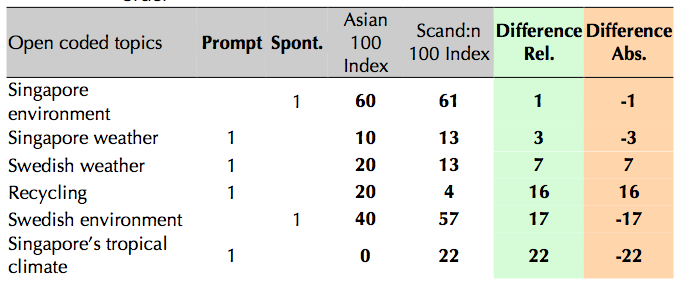
Table 4.32 Environment Category: Topics of concern for all respondents, sorted by relative difference in ascending order (Cordeiro-Nilsson 2009:188)
The only topic with more than 50% of both groups of respondents speaking of it was Singapore environment, which also had the smallest relative difference. The Singapore weather was also talked about as ‘common ground’ topic, although not many respondents in either group spoke of it. Topics with the greatest absolute differences in the direction of the Scandinavian respondents include Singapore’s tropical climate and talk about the Swedish environment. For the Asian respondents, only one topic indicated a larger interest in the direction of the Asian respondents and that is the topic of recycling. Recycling as a topic did not generate much interest in either group though, with rather low Asian and Scandinavian Indexes of 20 and 4 respectively. Example 4.x lends insight into talk of recycling a n d environmental awareness with Asian respondent A.
4.3 Concluding discussion
This chapter presented an overview of the results achieved from applying only the coding procedures from grounded theory (Strauss and Corbin 1998) to the interview transcripts, which renders a form of quantitative analysis of the 252 (spoken) topics discussed. The tables in general highlighted topics that were of interest to either group of respondents, depending on how the data was sorted. The numbers in the tables also indicated and pegged the existing differences of interest between the two groups of respondents for all topics.
Since the answers given by the respondents and the results are broadly based on the open / guided interview questions, one could possibly turn to the statistics yielded for the spontaneous topics as indication of the more natural interests of the respondents. With regards to speaking spontaneously, the two groups of respondents showed different characteristic traits when talking about the topics. The Scandinavians for example, took up more topics spontaneously overall, with a total of 4447 Scandinavian 100 Index, compared to the total of 4130 Asian 100 Index for spontaneous topics. The Asians however, were overall slightly more talkative in prompted topics, with a total of 3290 Asian 100 Index for prompted topics compared to the Scandinavian 100 Index total of 3082.
In explaining the implicit and explicit sorting found in the Main Table, Appendix A, some cultural studies saw Asian cultures as more collective in nature and more family oriented, where communication is steered more implicitly. With Asian cultures, messages and their meanings are gained as much via the surrounding context as is said with words (Hofstede, 1982, 1984; Triandis, 1995). As an example of how Asians can speak obliquely about a topic, Example 4.y illustrates how an Asian respondent L, does not say that the customer service during her visit to Scandinavia was inadequate or poor but rather talks about her own inadequacies, from her clumsiness to her petite frame and how she thought she looked rather silly dragging her luggage all the way to the hotel from the taxi:
Example 4.y
$L: i was like oh / i have to carry my own luggage / okay / fine / and it was so cold and i’m so clumsy because you’re wearing so many clothes right / glove lah / hat lah / all the stuff that you have on yourself / so clumsy / down here tropical much better / so by the time i drag drag drag drag drag ah / i think i looked such a fool / drag all the way there / and when i opened the door / i thought you have a bell boy or concierge or whatever lah / you know in asia / even hong kong service is excellent what / nobody helped me at all / some more i look so small sized ah / nobody helped me
While the explicit message from L focused on her inadequacies and self-consciousness, the implicit message could be perceived as L talking about the inadequate customer service in Scandinavia. L could also perhaps be talking about her experience of a culture shock. The text example begins from L’s realization that the taxi driver was not going to help her carry her luggage up to the hotel lobby in the middle of winter.
The total Asian 100 Index for implicit spontaneous topics is 240 compared to the total Asian 100 Index for explicit spontaneous topics at 173. The results of the coding procedures did indicate that the Asian respondents spoke more implicitly about things, referring to entities / happenings in an oblique manner when speaking on spontaneous topics, but whether this characteristic trait is due solely to the collective / family oriented nature of the Asian respondents and whether the coding procedures parallel findings in Triandis’s (1995) and Hofstede’s (1980, 1982, 1984) studies is uncertain, from just looking at the Main Table and its data.
The specific topics of interest in each category for each respondent group also indicate their varying perspectives on the themes discussed in the interviews, reflecting the interests of both groups of respondents and what they consider to be immediate concerns to themselves as individuals. For example, we saw that the Asians spontaneously chose to speak about their favourite local (Singapore) food whereas the Scandinavians spontaneously chose to speak about language as [a] barrier within the Individual category. On a personal level, many Scandinavians also spontaneously spoke of retiring in their home country whilst the Asians, who were mostly Singaporeans, spoke about their interest and knowledge in Singapore English. Similarities of interests can also be obtained from looking at the overall topics. For example, on the family and social level, both groups of respondents seem to speak about their family and how having a social life is difficult, whether it is socializing with colleagues after work for the Asian respondents or if it is the Scandinavians socializing with locals as not a common situation.
But while the coding procedures lend an overall statistical view of the similar / dissimilar interests of the two groups and it can reflect certain characteristic patterns of talk for the two groups, the topics in themselves cannot disclose how and in what manner or which perspective the respondents spoke about these topics. In keeping with the purpose of the grounded theory approach, the coding procedures are more useful in raising further questions (that are beyond the scope of this study) in theory building such as:
Questions regarding collectivistic and individualistic cultures and cultural dimensions:
• do these topics generally reflect the collective / individualistic cultures outlined by Triandis (1995)?
• do they correspond to the cultural dimensions of Hofstede’s (1980, 1982, 1984) studies?
Questions relating to culture specific observations are also raised by the coding procedures. The possibility of an existing ‘food culture’ in Singapore for example, has been implied by both groups of respondents with relatively high indexes, a 90 Asian Index and a 78 Scandinavian Index. The high indexes revealing that there has been a lot of interest in the topic of food (found in the Individual category).
Questions relating to culture specific observed behaviours:
• is there an existing ‘food culture’ in Singapore? And how integrated are the Asians and Scandinavians in terms of liking food from the Other culture?
Questions relating to other fields of study such as ‘knowledge transfer’ in the field of ‘information technology’ are also raised by the coding procedures. It was noted above for example, that the Asian respondents spoke more implicitly for spontaneous topics than for prompted topics, with a total Asian 100 Index of 239 to 152 respectively. But the total Scandinavian 100 Index for implicit spontaneous topics also records much higher than their total index for explicit spontaneous topics with 734 and 289 respectively. A possible dimension of further exploration could be:
Questions relating to other fields of research such as ‘knowledge transfer’ in the field of ’information technology:
• what types of knowledge reside in both groups of respondents? How does knowledge transfer occur between both groups of respondents?
From the above questions, it can be seen that the grounded theory coding procedures lays a foundation upon which hypotheses and theories can be built, acting as a ‘starting point’ of research, as it were, to further exploration of larger concepts.
In this study, the coding procedures helped primarily to indicate topics to be grouped together for further linguistic investigation. It helped to pinpoint important categories (by size and number of total topics) and salient features within the categories, that of hierarchy and assimilation / integration. And within these topics, the coding procedures also helped to highlight topics that were similar or dissimilar, occurring or non- occurring in either group of respondents.
As a continuation of the data sorting, the linguistic analysis in the next chapter will then address the following questions:
• how similar / dissimilar are each group of respondents views on management styles and on the concept of hierarchy?
• Do they have any cooperative or integrative efforts when working together?
• And if yes, what are these cooperative efforts?
The following chapter contains the linguistic analyses of text examples from the more salient topics of the largest category, the Organization category as revealed by the grounded theory coding procedures.

